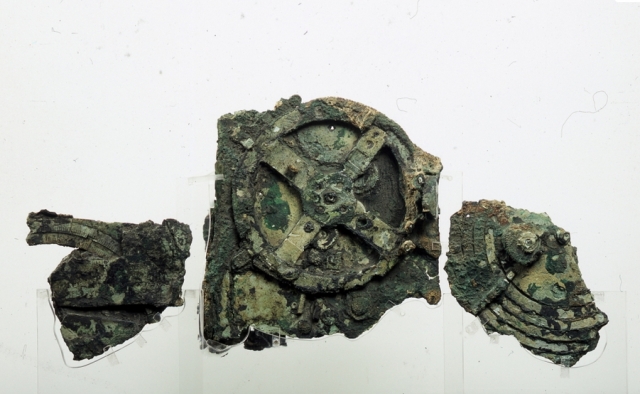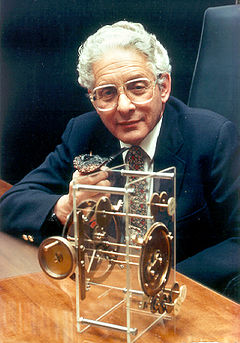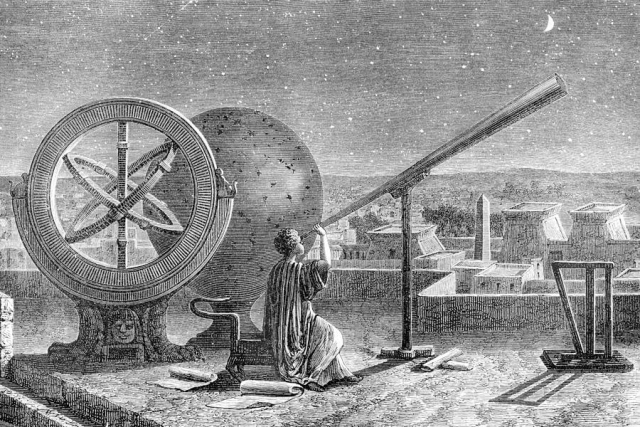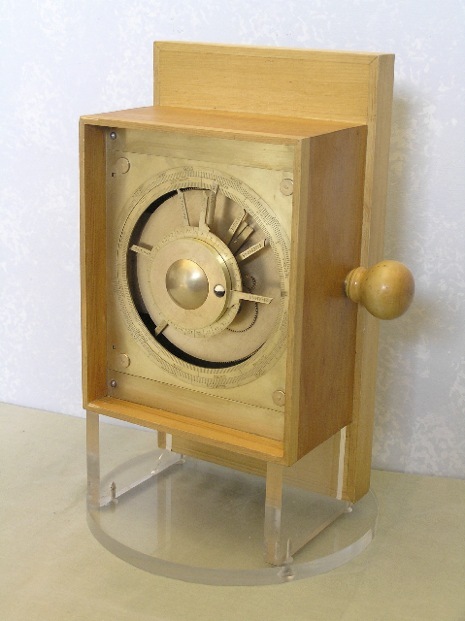Ivan Petkov
What connects ancient Greece, astronomy and computers? It is a device that has excited the scientific community for more than a century. It has brought together passionate researchers, groups on the Internet, engineers, mathematicians, astronomers, even fans of theories of extraterrestrial contact and of influence on the part of intelligent races from other planets that have had their impact on the development of mankind in the past. It is the Antikythera Mechanism. We have already informed you about this mechanism and you can see our photo report of the most interesting objects found on the discovered wrecked ship. New research has again aroused the spirits and it is time to present detailed information about this unique ancient "computer".

This is the original mechanism
It all started with doubt.
The mechanism was found near Antikythera Island, hence its name. Sponge divers found it at the beginning of the past century, in the year 1900, and initially it was not among the most remarkable discoveries. Two years later, Valerios Stais, an archaeologist from the National Archaeological Museum in Athens, suggested that the 82 pieces of bronze and about 32 wheels collected were parts of a complex mechanism. After British historian Derek J. de Solla Price drew the attention towards the mechanism in 1955 again, the first reaction of the scientific community was to doubt its dating. It was known by that time that the construction of the first such mechanisms had started as late as the 14th century. After two X-ray photographs taken in 1959 and 1971, scepticism grew as it was established that the gears used in the mechanism were found only in the 16th century whereas the creation of such compact mechanisms dated back to the 17th century.
 Derek J. de Solla Price
Derek J. de Solla Price
There were hypotheses that the mechanism had accidentally found itself among the ancient excavations, thus being added to the antiquities. The latest X-ray analyses were carried out in Athens in 2005 with a purpose-built tomographer that was brought from Britain. The powerful three-dimensional device showed signs in poor condition, some of which were only one tenth of a millimetre. By using modern technology and combining the multiple scanned fragments, the researchers were able to recover some of the inscriptions on the mechanism. They managed to decipher more than 2,000 characters, thus shedding new light on the purpose of the ancient computer. The findings confirmed that the mechanism was used to calculate the movement of the celestial bodies known to ancient Greeks, namely the Earth, Moon, Sun and the 5 planets closest to our own. The device is a precise astronomical calendar. Yiannis Batsakis, one of the co-authors of the study, states that such a mechanism was used for calculations relating to the Olympic and other games in ancient Greece.
Ancient people had developed intellect.
There is an underlying notion in our minds that human evolution follows an upward line, including in technical terms. We believe that if ancient people had different views, beliefs and ways of looking at things, they were at a primitive level. Discoveries like the Antikythera Mechanism show that ancient scientists did not differ from their modern counterparts and brilliant minds of mankind have always been ahead of the age in which they live in order to give a strong impetus to science and the progress of human society. Maybe it is time to accept that they were not primitive but intelligent, and possessed more knowledge and skills than we tend to acknowledge.
Astrology and astronomy.
Today, many of us ridicule astrology and believe astronomy is a true science. In our section "Astro school", we try to show that the two sciences are two sides of the same coin.

Ancient astronomers did not draw a line between them. They used a whole range of natural sciences to describe the phenomena that influence nature and the rhythm of human existence and determine them. We can look at the Antikythera Mechanism as not only a marvel of technological thought, but also as a historical artefact showing certain influences and connections in the ancient world. Some scientists believe that the mechanism clearly shows the relationship between the astronomy schools in Babylon and ancient Greece and that the Greek school received and developed a lot of knowledge from its forerunner.
The idea that lies behind this ancient computer is simple, namely to follow the cycles of the two celestial bodies that dictate the rhythm of life on Earth - the Sun and the Moon. Put in this way, everyone would think that this was not a very difficult task. The problem is that the rotation of the two celestial bodies in the sky, which sustains life on Earth, does not correspond to one astronomical year. Ancient Greeks knew that there were exactly 29.5 days from one new moon to another. Here is the problem, namely that one year has 354 days counted on the basis of the lunar cycle, which has 11 days less than the solar year that has 365 days. Thus, the so-called solar or natural year that determines the seasons differs from the lunar year. Greek astronomer Meton, who discovered that the two cycles coincide every 19 years, resolved this problem by calculating that 19 solar years equal 235 lunar months. Thus, it seemed that the problem was solved. This was so in purely mathematical terms but not from an engineering point of view.
A pure engineering mind.
As a good friend of mine, an engineer, used to say, after theorists do their job it is the engineers’ turn, as they have to figure out how to implement it in practice. The metal available to ancient engineers to make this mechanism was bronze. Making a wheel with 235 cogs that correspond to the 235 lunar months was not only a complicated task but it did not solve other problems faced by engineers, namely that the celestial bodies do not move in perfect circles and at the same speed. On the contrary, the Moon moves in an ellipse, and when it is close to Earth its movement accelerates and when it is away, it slows down. This means that, in order for ancient scientists to forecast the exact speed of the Moon, they had to find a way to accelerate the movement of the mechanism and slow it down so that it could be accurate. Of course, they coped with this task using a system of ingenious reporting mechanisms and arrows. It is believed that the first mechanisms were of much greater size but they were able to reduce their size over time and to fit them into a portable wooden box.
What was the function of the mechanisms?
We already mentioned the calculations relating to different games. They were probably made to determine every kind of periodical events the calculation of which, in terms of the optimal alignment of the celestial bodies, was essential for people in antiquity. In addition to the phases of the Sun and Moon, along with the correct forecasts of their eclipses, ancient scientists were interested in their colour too. We know that the red glow of the Moon (Blood Moon) occurs in certain circumstances. Ancient people wanted to know when it would happen as it was considered a bad omen and it was one of the reasons for the sinking of half of the Athenian fleet at Syracuse in 413 BC. Nicias, who led the Athenian fleet, perceived the red moon as a bad omen and that weakened the determination of the Athenian warriors. If the navy had such a device, probably the events would have taken place in another way, avoiding the siege during the "Blood Moon."
Origin of the Antikythera Mechanism.
 Posidonius
Posidonius
One hypothesis is that it was constructed in the academy of ancient Stoic philosopher Posidonius of Rhodes, which was considered a centre of astronomical science and engineering at that time. The linguistic analysis of the inscriptions found during the latest scanning of the mechanism suggests that it was probably made in the colony of Corinth on the island of Sicily, which directly refers to one of antiquity’s indisputably greatest minds, Archimedes.
 Archimedes
Archimedes
Probably the great scientist was not directly involved in its development, shouting "Eureka" in inventing it, since he died more than 60 years before the appearance of the mechanism that dates back to 150 BC and 100 BC.

The modern reconstruction of the mechanism carried out by one person without the intervention of modern machines shows that it takes more than 1,000 hours to make such a mechanism. The reconstruction used mainly tools that were known in antiquity but there were some exceptions, including a vice and watchmaker’s glasses. All this shows that the making of a single mechanism required great patience, persistence and work. The question that remains is why other similar mechanisms that appeared only after more than 1,300 years have not been found.
Researchers say the reasons are complex, as due to the difficult making, such mechanisms were extremely rare and had great value. This explains the presence of this mechanism along with bronze statues aboard the sunken ship where it was found. Another feature indicates that it was almost impossible to repair the mechanism, which means a relatively short life and use of the material for other purposes afterwards. From the historical reasons, we can mention the fact that Greece was conquered by the Roman Empire and the stored knowledge subsequently passed into the Byzantine Empire, where, because of Christianity, it was not highly respected. After the fall of Byzantium, the engineering knowledge became the property of Arabs and only after the beginning of the Renaissance in Europe, it returned to the European civilization, along with the writings of Aristotle and other valuable knowledge.
Not all about the mechanism has been explained. The article makes it clear that, decade after decade, scientists continue to reveal more and more details about this ancient computer that, as an achievement, is equivalent to the laptop of our time, if not much more. Mysteries kindle the imagination of various researchers, giving rise to paleocontact theories associated with ancient history. These theories say that an extraterrestrial civilization that was much more advanced in its development had established contact with the ancient civilizations, sharing knowledge to the benefit of our predecessors. This knowledge led to qualitative leaps in human civilization. Definitely, the Antikythera Mechanism, with its complexity and mysteriousness, has become the subject of such theories. It is up to you to decide which of the theories seems the most plausible.